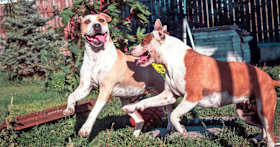What Type of Dog Fence Should I Get?
Choosing the right fence for your dog is more than just a matter of keeping them from running away. Here’s what you should keep in mind before buying one.
Choosing the right fence for your dog is more than just a matter of keeping them from running away. Here’s what you should keep in mind before buying one.
by Emily Johnson, | November 18, 2024

Rachel Bellinsky / Stocksy
A dog fence provides safety, security, and peace of mind — not just for your dog, but also for you. Pet parents should consider various factors, including your pet's size, breed, and behavior, as well as your property’s characteristics. Whether you’ve got a small, curious pup or a large, energetic breed, the right fence can help create a safe space for play and exercise.
From classic wooden to chain-link fences, each type of dog fence offers unique benefits and drawbacks. In this article, we’ll explore different fencing options, discuss what to consider when making your choice, and give some tips to help you make the best decision for your dog’s needs.
Not all dogs have the same needs when it comes to fencing. A large breed like a German Shepherd might require a tall, durable fence but be fine with more space-out slats. However, a small dog might be good with something lower, but would need it fully enclosed since they could potentially squeeze through fence openings.
Similarly, high-energy dogs might need a fence that’s extra sturdy or particularly escape-proof. Think about how your dog acts when they’re outside — whether they’re a jumper, a digger, or just like to sunbathe — and choose a fence that matches their temperament.
Your yard’s layout plays a big role in determining the type of fence that will work best. If your property is large or uneven, you’ll need a fence that can accommodate dips and slopes. A flat yard is simple to fence, but if your yard is hilly or has heavy foliage, you might need a more customizable fencing solution.
Some cities or municipalities have rules about the height or type of fence you can install. Before you commit to a specific type, check with local ordinances to make sure your fence will meet zoning laws and property guidelines. It can save you from having to make costly changes later on.
If you live in a neighborhood with a homeowners association (HOA), be sure to check the rules before installing a fence. Some HOAs have strict regulations about fence styles, colors, or materials, which can limit your options.
While practicality is the priority, aesthetics might also play a part in your decision. Do you want a fence that blends into your yard’s landscape or adds a decorative touch to your space? Wooden fences tend to offer a more natural look, while vinyl or aluminum might give your yard a sleeker, more modern vibe.
Protecting your pup from wildlife is another important consideration, especially if you live in areas with large predators such as foxes or coyotes. Coyotes, for instance, can easily scale a standard six-foot fence. An eight-foot fence should be the baseline for keeping your pup safe if your area is known for coyote activity.
Wooden fences are a classic choice that offers both privacy and security for dogs. They’re great for dogs who are easily distracted or reactive to things outside the yard, since the solid panels block visual stimuli. However, if your dog is a chewer or digger, you’ll need to regularly inspect for wear and tear as wood can be more easily damaged.
Chain link fences are a budget-friendly option, particularly for large yards or dog parents who don’t need a lot of privacy. They’re durable and hard to damage, making them a solid choice for larger or more energetic dogs. However, chain link fences can be easy to climb if your pup is motivated to escape, so this may not be the best choice for a dog known to be a jumper or climber.
Aluminum fences offer both durability and style, making them a great choice for pet parents with large, strong dogs. These fences are resistant to rust and weathering, which is perfect if your dog spends a lot of time outdoors in all seasons. The open style of aluminum fences also gives your dog a clear view of their surroundings, so if you have a curious pup who likes to watch the property, this could be a good option.
On the other hand, if your dog is a barker or is small enough to slip through the spacing, you may want to think about something more solid.
Vinyl fences are durable, low-maintenance options for dog parents. The solid structure can provide privacy and help prevent reactive dogs from seeing passersby or animals outside the yard. And because vinyl doesn’t splinter or rot like wood, it’s also a great choice for dogs who tend to chew on fences. Just be sure to choose a sturdy vinyl model that can handle a large or energetic dog without buckling.
Picket fences offer a more decorative look, but they can still serve as an effective barrier for smaller or calmer dogs. If you have a toy breed or a dog who’s not prone to escaping, a picket fence may be all that you need. However, because these fences are often shorter and have gaps between the slats, they might not be best for escape artists or dogs who can squeeze through narrow spaces.
For maximum security and strength, a masonry fence (e.g. stone or brick) provides a nearly impenetrable barrier. This is an excellent option for larger breeds or dogs who are particularly strong jumpers or prone to escaping. The solid construction can’t be chewed or knocked over, and it offers full privacy. However, these fences are permanent and can be expensive to install, so they’re best for pet parents looking for a long-term fix.
Wire fencing is one of the most affordable and flexible options for dog parents, especially for large properties or rural areas. This type of fence is typically made from galvanized steel wire, and it can be installed as a DIY project, making it a popular choice for those on a budget. Wire fences work well for keeping dogs safe while allowing them to see their surroundings.
However, wire fences aren’t always the best option for diggers or climbers. Reinforcing the bottom of the fence may prevent digging under but could be warped or bent, and the wire could potentially be climbed by a determined dog.
Though invisible or electric fences might seem like an easy solution, many vets and trainers advise against them. Electric fences work by delivering a mild shock to your dog when they cross a boundary, but this can cause unnecessary stress or anxiety and lead to a fearful, reactive, even aggressive dog. A lot of pet adoption agencies also frown upon potential homes that have electric fences.
Additionally, electric fences don’t prevent other animals (such as coyotes) or people from entering your yard, which can pose risks to your pup. A traditional fence not only keeps your dog safe but also creates a physical barrier to protect your property from outside threats.
These budget-friendly dog fences may provide you with the right security and safety for your dog without breaking the bank.
Wire fencing — Wire fencing, such as welded wire or chain link, is one of the most affordable options for dog containment. It’s easy to install, and if you’re handy, it can even be a DIY project. This type of fence is ideal for large yards or rural properties where you need to fence off a significant area while on a budget.
DIY fencing solutions — For a truly budget-conscious option, consider building your own fence using repurposed or low-cost materials. Pallets, for example, can be an inexpensive way to create a sturdy fence.
Temporary fencing — If you’re looking for a short-term or portable solution, temporary fencing might be the best option. Portable dog fences or exercise pens can be set up quickly and moved as needed. They’re particularly useful for small dogs or when you need to contain your dog in a specific area of your yard.
Mesh or plastic fencing — Mesh or plastic fencing is another low-cost option. It’s typically made from flexible plastic or mesh material that can be attached to stakes or posts around your yard. This fence can work well for small or low-energy dogs who don’t try to escape.
While these budget-friendly fencing options might save you money upfront, it’s important to consider their long-term use. A more expensive fence, such as vinyl or aluminum, could be a better investment in the long run, especially if you have a large dog or one who likes to test boundaries.
While most fencing can handle small dogs, pet parents of large dog breeds should keep a few things in mind before choosing which fence to install.
Large dogs often need taller fences to prevent them from jumping over. For breeds like Great Danes or Huskies, a fence that’s at least six feet tall is usually recommended. Anything shorter might be an invitation for your dog to escape, especially if they’re particularly energetic or prone to wandering the neighborhood.
For dogs who are known escape artists, you’ll need to take extra precautions. This might include installing a fence with a smooth surface that’s difficult to climb or adding an inward-facing topper that discourages jumping over it. You may also need to consider putting in a digging barrier (i.e. burying the fencing a few feet into the ground) to stop your dog from tunneling out.
Some large dogs are strong enough to break through weaker materials, so it’s important to choose a fence that can stand up to the wear of chewing or impact from jumping. Metal fences, such as aluminum or chain link, tend to be more durable against large breeds who might test their limits.
Training your dog to stop barking starts with understanding why they’re barking. Dogs bark for different reasons — boredom, attention, fear, excitement, etc. Once you identify the cause, you can start training to curb the behavior. For example, if your dog is barking for attention, avoid reinforcing it by giving in to their demands. Instead, reward quiet behavior with treats and praise. You can also use commands like “quiet” or “enough” to teach them when it’s time to stop barking. Consistency is key, so be patient and persistent with your training.
Dogs escape or run away for a variety of reasons, including boredom, anxiety, or even a strong prey drive. If your dog isn’t getting enough physical or mental stimulation, they might try to escape to find something more exciting to do. Separation anxiety can also lead dogs to try and break out of the yard in search of their pet parents. Other dogs might escape to chase after a squirrel or the neighborhood cat or to interact with other dogs walking by. To prevent escapes, ensure your dog gets enough exercise, provide mental enrichment like toys or puzzles, and check that your fence is secure and high enough to prevent any escape attempts.
The Best Portable Dog Fence For Camping? Our 10 Favorite Temporary Dog Fencing Solutions
Helpful Ways to Make Your Dog Happy
The Pros and Cons of Invisible Fences for Dogs
SpotOn Virtual Smart Fence Review — Is This the Right Product for You?
What Type of Dog Fence Should I Have?
What Size Dog Fencing Should You Get? Tips and Overall Guide

Emily Johnson is a long-time pet writer and animal lover, working with brands like PetMD, Rover, Kinship, and more. She’s cared for dogs, cats, and horses her entire life and strives to help fellow pet parents through her content.

Shelters & Rescue

Behavior & Training

Behavior & Training

Adoption Advice
Adopting a new puppy can shake-up the doggy dynamics at home. Here’s how to keep the peace and harmony among your pets.


Adoption Advice
Here’s everything there is to consider before adopting a second dog.

Shelters & Rescue
In truth, most animal shelters will identify and treat a pet’s health problems pretty quickly. They’ll have all the information you need.

Adoption Advice
Are you new to dog adoption? We’ve got you covered with this comprehensive checklist. It’s everything a first-time pet parent needs to prepare for their new pup.

Behavior & Training
Some dogs just need a bit of training and encouragement to help them overcome undesired behaviors.